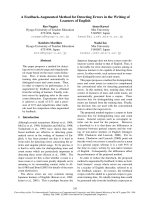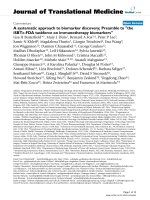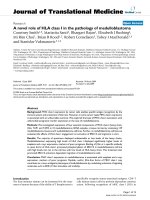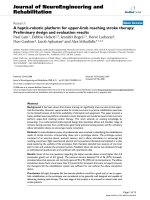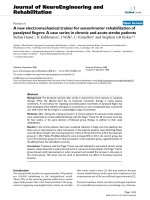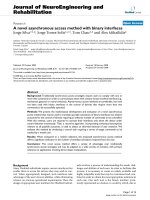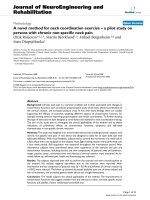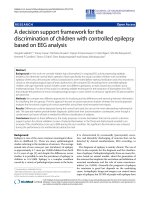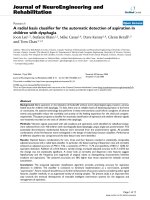Báo cáo hóa học: " A novel adenovirus vector for easy cloning in the E3 region downstream of the CMV promoter" pot
Bạn đang xem bản rút gọn của tài liệu. Xem và tải ngay bản đầy đủ của tài liệu tại đây (348.2 KB, 4 trang )
BioMed Central
Page 1 of 4
(page number not for citation purposes)
Virology Journal
Open Access
Short report
A novel adenovirus vector for easy cloning in the E3 region
downstream of the CMV promoter
Laurent Mailly
1,2
, Charlotte Boulade-Ladame
1
, Georges Orfanoudakis
1
and
François Deryckere*
1
Address:
1
Unité Mixte de Recherche 7175, Ecole Supérieure de Biotechnologie de Strasbourg, Illkirch, France and
2
Unité Inserm 748, Institut de
Virologie, Strasbourg, France
Email: Laurent Mailly - ; Charlotte Boulade-Ladame - ;
Georges Orfanoudakis - ; François Deryckere* -
* Corresponding author
Abstract
The construction of expression vectors derived from the human adenovirus type 5 (Ad5), usually
based on homologous recombination, is time consuming as a shuttle plasmid has to be selected
before recombination with the viral genome. Here, we describe a method allowing direct cloning
of a transgene in the E3 region of the Ad5 genome already containing the immediate early CMV
promoter upstream of three unique restriction sites. This allowed the construction of recombinant
adenoviral genomes in just one step, reducing considerably the time of selection and, of course,
production of the corresponding vectors. Using this vector, we produced recombinant
adenoviruses, each giving high-level expression of the transgene in the transduced cells.
Findings
The most commonly used method for generating recom-
binant adenoviral vectors is based on homologous recom-
bination in E. coli [1,2]. This method requires a first
cloning step into a shuttle plasmid containing a promoter
for the expression of the transgene. After selection of
recombinants, the plasmid DNA of each clone has to be
transferred into an other bacterial strain (i.e. DH5α,
DH10b) because the homologous recombination is per-
formed with BJ5183 E. coli strain [3] that does not allow
for production of large quantities of plasmid. Improve-
ments to this method have been made by using Top10F'
bacteria that produce a high copy number of plasmids [4]
or in vitro ligation for the subcloning of a gene of interest
in the viral genome [5-7]. However, although these tech-
niques allow efficient generation of recombinant adeno-
viral genomes, two-step plasmid manipulation is
necessary.
Here, a simple approach for generating an Ad5 derived
expression vector is described. The first step was to con-
struct pAd5CMV/TCS, a plasmid containing the Ad5
genome deleted of E1 and containing the immediate early
CMV promoter (CMVp) upstream of a triple cloning site
(TCS) composed of three unique restriction sites (SwaI,
BstBI, ClaI) in replacement of the E3 region. To obtain
pAd5CMV/TCS, two DNA fragments surrounding the E3
region were PCR-amplified (for primers see Table 1),
using pTG3622 [1] as template, and sequentially cloned
on either side of the CMVp in pcDNA3 to give the pLeft/
Right plasmid. Thereafter, annealed oligonucleotides,
containing the TCS, were inserted into the BamHI/NotI
opened pLeft/Right to obtain the pLeft/Right/TCS. This
Published: 6 June 2008
Virology Journal 2008, 5:73 doi:10.1186/1743-422X-5-73
Received: 4 April 2008
Accepted: 6 June 2008
This article is available from: />© 2008 Mailly et al; licensee BioMed Central Ltd.
This is an Open Access article distributed under the terms of the Creative Commons Attribution License ( />),
which permits unrestricted use, distribution, and reproduction in any medium, provided the original work is properly cited.
Virology Journal 2008, 5:73 />Page 2 of 4
(page number not for citation purposes)
plasmid was then used to replace the E3 region by the
CMVp and TCS, in pTG3622, using homologous recombi-
nation in E. coli as previously described [1] to obtain
pAd5CMV/TCS (Fig. 1A).
Four different constructs were inserted into pAd5CMV/
TCS to drive the expression of either the enhanced green
fluorescent protein (EGFP), thymidine kinase from Her-
pes Simplex Virus type 1 (TK), a TK/EGFP fusion protein
or a mutated form of the HPV16 E6 protein (Fig. 1A) [8].
The EGFP ORF and the SV40 polyadenylation site from
the pEGFP-C3 (Clontech, Saint-Germain en Laye, France)
was inserted using the Swa I and Cla I restriction sites after
PCR amplification (primers are listed in Table 1). For the
resulting plasmid, pAd5-EGFP, it is possible to exchange
the EGFP ORF (using SwaI and BstBI) while keeping the
SV40 polyadenylation site (Fig 1A).
The TK ORF was PCR-amplified from pMBP-TK [9] and
inserted into pAd5-EGFP either in replacement of the
EGFP ORF (SwaI-BstBI) or fused upstream of the EGFP
coding sequence (SwaI). E6mut, a flag-tagged dominant
negative mutant of HPV16 E6 protein (E6-6C/6S-F47R-
ΔPDZ), was also successfully sub-cloned [8]. This was
achieved by inserting a Klenow-repaired EcoRI fragment
containing the E6mut ORF into the SwaI site of
pAd5CMV/TCS. For each construction, a good ratio of
positive clones was obtained, respectively 14/20, 6/20,
12/20 and 3/10, in only three days (from the start of clon-
ing until the plasmid preparation and restriction verifica-
tion).
The four corresponding recombinant adenoviruses were
produced in 293 cells following classical procedures [10]
and tested on HeLa cells. The expression of the different
proteins was examined by Western blotting (Fig 1B),
EGFP fluorescence and immunofluorescence (Fig 1C).
This demonstrated that (i) cells are were efficiently trans-
duced, (ii) the fusion protein TK/EGFP conserved the
green fluorescence conferred by its EGFP moiety, (iii) the
fusion TK/EGFP conserved the TK epitopes, and (iv) the
E6 mutant protein was well expressed and recognized by
both anti-E6 and anti-Flag antibodies. Cells expressing TK
are sensitive to the pro-drug ganciclovir and the ability of
the fusion product to induce cell death was investigated
using a Methylthiazolyldiphenyl-tetrazolium bromide
(MTT) assay (Fig. 1D). This test demonstrated that both
TK and TK/EGFP induced the death of HeLa cells after
treatment with ganciclovir.
This approach can be easily used in any laboratory to rap-
idly produce recombinant adenoviruses. For this, a new
vector derived from Ad5 has been created by inserting, in
replacement of the E3 region, the CMVp followed by three
unique restriction sites (SwaI, BstBI,ClaI) that are absent
from a ΔE1 Ad5 genome. This triple cloning site allows the
easy cloning of a transgene that will be expressed from the
CMVp. In addition, pAd5-EGFP, allows the cloning a
cDNA of interest between the CMV promoter and the
SV40 polyadenylation signal either in replacement of the
EGFP ORF or in fusion with it. This is also possible with
this vector to clone a second transgene in the E1 region by
using homologous recombination in E. coli as previously
described [2]. Four different transgenes were inserted into
pAd5CMV/TCS. The construction of the corresponding
genomes, contained in plasmids, was rapidly achieved (3
days instead of 7 to 10 days with homologous recombina-
tion in E. coli). In each case, a much higher proportion of
Table 1: Oligonucleotides used in this study (restriction sites are in bold)
Oligonucleotides used for: 5'-3' sequences length of amplified fragments (bp)
Amplification of E3 flanking regions CGCGACGCGTTTCGACAGGGCTAC
CGCGACGCGTGTTTCAGGCGCAGTTG 2731
CCCTAGATCTAGAAATGGACG
GCGTCTAGATCCAATATTCTGGGTCC 2013
Insertion of TCS in adenovirus genome GATAACAGATTTAAATCCTTCGAACAGAATCGAT
GGCCATCGATTCTGTTCGAAGGATTTAAATCTGTT
PCR to check pAd5CMV/TCS CGTGTCATATGGATACACGGG
TCCAGCATGGCTACAACCTC 2643
EGFP amplification from pEGFPC3 AGGAAAAAAATTTAAATCCACCATGGTGAGCAAGGGCGA
GGAGCT
AGGAAAAAAATCGATCGCGTTAAGATACATTGAGTTTGGA
C
1034
PCR to check pAd5CMV-EGFP GGCACCAAAATCAACGGGAC
AGGAAAAAAATCGATCGCGTTAAGATTACATTGAGTTTGGA
C
2312
Amplification of TK from pMBP-TK AGGAAAAAAATTTAAATGCGCGTATGGCTTCGTAC
AGGAAAAAAATTTAAATGAGTTAGCCTCCCCCATC 1129
AGGAAAAAATTCGAATCAGTTAGCCTCCCCCATC 1129
Virology Journal 2008, 5:73 />Page 3 of 4
(page number not for citation purposes)
Expression of EGFP, TK, TK/EGFP and E6mut in HeLa cells after transduction with Ad5-EGFP, Ad5-TK, Ad5-TK/EGFP and Ad5-E6mutFigure 1
Expression of EGFP, TK, TK/EGFP and E6mut in HeLa cells after transduction with Ad5-EGFP, Ad5-TK, Ad5-
TK/EGFP and Ad5-E6mut. (A) Restriction map of pAd5CMV/TCS and of the 4 different inserts. (B) HeLa cells were seeded
on 24 well plates (1.2 × 10
5
cells/well) and transduced the next day with the different Ad vectors at a MOI of 1000. The TK/
EGFP encoded fusion protein consisted of the entire TK protein at the N-terminus, a peptide linker SFKST and the complete
EGFP protein at the C-terminus. Western-blotting analyses were carried out as described, using rabbit anti-TK antibody
(obtained from William C. Summers, Yale University, New Haven, dilution 1/1300), mouse anti-EGFP antibody (Roche Diag-
nostics, dilution 1/1000), rabbit anti-Flag antibody (Sigma, dilution 1/2000) or mouse anti-HPV16 E6 protein antibody (1/500)
[11]. (C) HeLa cells were seeded on 24 well plates and transduced as described above. Cells were fixed and treated for
immunofluorescence microscopy as described [11] with anti-TK antibody (1/1300), with anti-Flag antibody (1/1000), or with
anti-E6 antibody (1/1000) and with a goat anti-rabbit antibody coupled to Alexa 568 (Molecular Probes, dilution 1/1000) or
goat anti-mouse antibody coupled to Alexa 488 (Molecular Probes, dilution 1/1000). The nuclei were stained with Hoechst
33342 for 5 min at room temperature. Cells were viewed using a Zeiss Axioplan microscope (D) Cells were seeded and trans-
duced as described above. Forty-eight hours after infection, cells were incubated, or not, with ganciclovir (GCV) at 20 μg/mL.
Four days later, surviving cells were analyzed using the MTT test (M2003, Aldrich-Sigma, St Quentin Fallavier, France) as
described previously [12]. This test was performed in triplicates, error bars are standard deviations.
A
B
TK/EGFP
(71 kDa)
HSV-1 TK
(41 kDa)
Ad5-TK/EGFP
Ad5-TK/EGFP
EGFP
(30 kDa)
Mock
Mock
Ad5-TK
Ad5-TK
Ad5-EGFP
Ad5-EGFP
Anti-TK Anti-EGFP
+ GCV
- GCV
OD-595
0.0
0.1
0.2
0.3
0.4
0.5
Mock Ad5-EGFP Ad5-TK Ad5-
TK/EGFP
C
Ad5-E6mut
Mock
E6mut (18 kDa , Anti-Flag)
D
CMV promoter
SwaI
BstBI
ClaI
Amp
R
PacI
PacI
ITR
ITR
pAd5CMV/TCS
Anti-TK
EGFP
Hoechst
Mock
Ad5-EGFP
Ad5-TK
Ad5-TK/EGFP
Anti-E6
Anti-Flag
Ad5-
E6mut
Mock
Hoechst
SwaI
BstBI
ClaI
EGFP SV40 pA
SwaI
BstBI
ClaI
TK SV40 pA
SwaI
BstBI
ClaI
TK/EGFP SV40 pA
SwaI
BstBI
ClaI
E6mut SV40 pA
E6mut (18 kDa , Anti-E6)
Publish with BioMed Central and every
scientist can read your work free of charge
"BioMed Central will be the most significant development for
disseminating the results of biomedical research in our lifetime."
Sir Paul Nurse, Cancer Research UK
Your research papers will be:
available free of charge to the entire biomedical community
peer reviewed and published immediately upon acceptance
cited in PubMed and archived on PubMed Central
yours — you keep the copyright
Submit your manuscript here:
/>BioMedcentral
Virology Journal 2008, 5:73 />Page 4 of 4
(page number not for citation purposes)
positive clones after ligation into pAdCMV5-TCS (30–
70%) was obtained when compared to homologous
recombination (15% at best in our laboratory). The con-
structs led to the production of infectious adenoviral par-
ticles that allowed the high-level expression of the
different transgenes. This method of construction of ade-
novirus vectors is clearly faster and easier than conven-
tional approaches and can be used by those who are not
familiar with the homologous recombination system.
Competing interests
The authors declare that they have no competing interests.
Authors' contributions
Design and conception of study (FD, GO); plasmid con-
structs and production of viruses (LM); gene expression
analysis (LM, CB-L); manuscript preparation (LM, FD).
All authors read and approved the final manuscript.
Acknowledgements
We acknowledge Emiliana Borrelli (IGBMC, Strasbourg) and the Transgene
company (Strasbourg) for the gift of plasmids and Philip Robinson (CHU
Bordeaux) for careful reading and fruitful discussion. This work was sup-
ported by the Université Louis Pasteur de Strasbourg, the Centre National
de la Recherche Scientifique, the Association pour la Recherche contre le
Cancer, the Ligue Nationale Contre Le Cancer and the Cancéropôle-
Grand-EST. L.M. was supported by a postdoctoral fellowship from the Can-
céropôle-Grand-EST and C.B-L was supported by the Ministère de la
Recherche.
References
1. Chartier C, Degryse E, Gantzer M, Dieterle A, Pavirani A, Mehtali M:
Efficient generation of recombinant adenovirus vectors by
homologous recombination in Escherichia coli. J Virol 1996,
70(7):4805-4810.
2. He TC, Zhou S, da Costa LT, Yu J, Kinzler KW, Vogelstein B: A sim-
plified system for generating recombinant adenoviruses. Proc
Natl Acad Sci U S A 1998, 95(5):2509-2514.
3. Hanahan D: Studies on transformation of Escherichia coli with
plasmids. J Mol Biol 1983, 166(4):557-580.
4. Renaut L, Bernard C, D'Halluin JC: A rapid and easy method for
production and selection of recombinant adenovirus
genomes. J Virol Methods 2002, 100(1-2):121-131.
5. Mizuguchi H, Kay MA: Efficient construction of a recombinant
adenovirus vector by an improved in vitro ligation method.
Hum Gene Ther 1998, 9(17):2577-2583.
6. Mizuguchi H, Kay MA: A simple method for constructing E1-
and E1/E4-deleted recombinant adenoviral vectors. Hum
Gene Ther 1999, 10(12):2013-2017.
7. Mizuguchi H, Kay MA, Hayakawa T: In vitro ligation-based cloning
of foreign DNAs into the E3 and E1 deletion regions for gen-
eration of recombinant adenovirus vectors. Biotechniques 2001,
30(5):1112-4, 1116.
8. Nomine Y, Masson M, Charbonnier S, Zanier K, Ristriani T, Dery-
ckere F, Sibler AP, Desplancq D, Atkinson RA, Weiss E, Orfanoudakis
G, Kieffer B, Trave G: Structural and functional analysis of E6
oncoprotein: insights in the molecular pathways of human
papillomavirus-mediated pathogenesis. Mol Cell 2006,
21(5):665-678.
9. Mathis C, Hindelang C, LeMeur M, Borrelli E: A transgenic mouse
model for inducible and reversible dysmyelination. J Neurosci
2000, 20(20):7698-7705.
10. Mailly L, Renaut L, Rogee S, Grellier E, D'Halluin JC, Colin M:
Improved gene delivery to B lymphocytes using a modified
adenovirus vector targeting CD21. Mol Ther 2006,
14(2):293-304.
11. Lagrange M, Charbonnier S, Orfanoudakis G, Robinson P, Zanier K,
Masson M, Lutz Y, Trave G, Weiss E, Deryckere F: Binding of
human papillomavirus 16 E6 to p53 and E6AP is impaired by
monoclonal antibodies directed against the second zinc-
binding domain of E6. J Gen Virol 2005, 86(Pt 4):1001-1007.
12. Lagrange M, Boulade-Ladame C, Mailly L, Weiss E, Orfanoudakis G,
Deryckere F: Intracellular scFvs against the viral E6 oncopro-
tein provoke apoptosis in human papillomavirus-positive
cancer cells. Biochem Biophys Res Commun 2007, 361(2):487-492.

